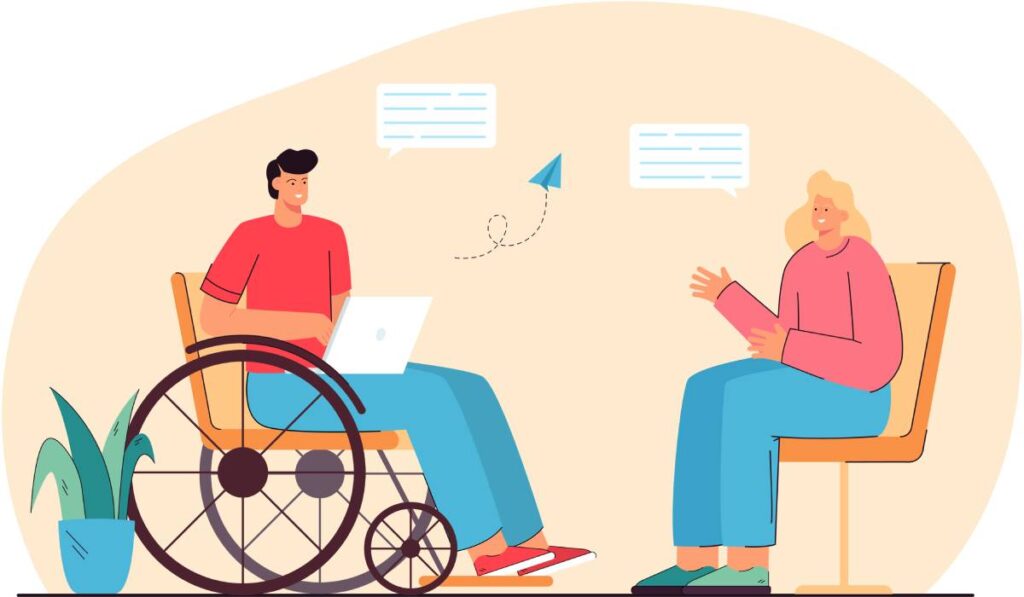Embracing inclusion: Communicating about people with disabilities

As we bid farewell to Disability Pride Month, let’s take a moment to delve into an important topic that fosters inclusivity in our daily lives: Communication about people with disabilities. Demonstrating respect, kindness, and inclusivity in our interactions is crucial, so let’s jump right in and explore some tips on how we can improve the way we talk about individuals with disabilities.
Person-first vs identity-first language
What does it mean to use person-first language? It means recognizing the person as an individual before focusing on their disability. For instance, instead of saying “disabled John,” we can say “John with a disability.” This simple change shows respect and reminds us that their disability is just one aspect of their identity. It’s a wonderful way to be more inclusive and considerate.
However, it’s essential to acknowledge that some individuals choose to embrace their disability as a vital part of who they are. For example, they may prefer terms like “deaf individual like John” or “Mary, who has a learning disability.”
Which approach should you take? Always ask the individual you’re addressing how they wish to be identified. If you’re unable to get confirmation beforehand, it’s best to default to the person-first approach.
Avoid disability labels and stereotypes
Labels and stereotypes can be hurtful, so let’s steer clear of them when discussing people with disabilities. Some harmful biases that people with disabilities have encountered include
- Assuming disabled people can’t be leaders
- Believing disabled people are difficult employees
- Presuming disabled people aren’t reliable
- Thinking disabled people can’t carry a full workload
- Believing disabled people are too expensive to employ
Remember, each person’s disability is just one part of their unique identity. Let’s take the time to listen, understand, and appreciate their story and strengths. Embracing their differences and acknowledging their abilities alongside any challenges they may face fosters genuine inclusivity.
Use clear and easy-to-understand communication
Communication is a two-way street, so let’s ensure our messages are clear and accessible to everyone. When speaking with someone with a hearing impairment, face them directly, speak clearly, and consider using visual aids or written information. For individuals with visual impairments, offer information in various formats, such as text that can be read by a screen reader or audio recordings. By making our communication accessible to all, we ensure that nobody feels left out.
Respect boundaries and offer help thoughtfully
Independence and autonomy matter to everyone. Rather than assuming what someone needs, it’s better to ask if they would like assistance. For instance, don’t push someone’s wheelchair without asking or grab a blind person’s arm. Respectfully inquire if they require help and follow their lead. Offering assistance with understanding and consideration can have a positive impact and create an environment where individuals feel valued and empowered.
Conclusion
By approaching people with disabilities with respect, empathy, and inclusivity, we can build a society that celebrates diversity and provides equal opportunities for everyone. Let’s be mindful of our words, avoid stereotypes, and truly listen to one another. Remember, it’s not about being perfect; it’s about making a genuine effort to learn and grow. Together, we can build a world where everyone feels seen, heard, and valued for who they are. So, let’s embrace inclusion, one conversation at a time.
Before you go, I’ve got something exciting for you! If you want to delve deeper into this topic and have a good laugh while learning, I’ve got just the thing for you. You won’t want to miss the amazing TED Talk by Stella Young called “I’m not your inspiration, thank you very much.” So, grab some popcorn, sit back, and enjoy the video below. Happy watching!


